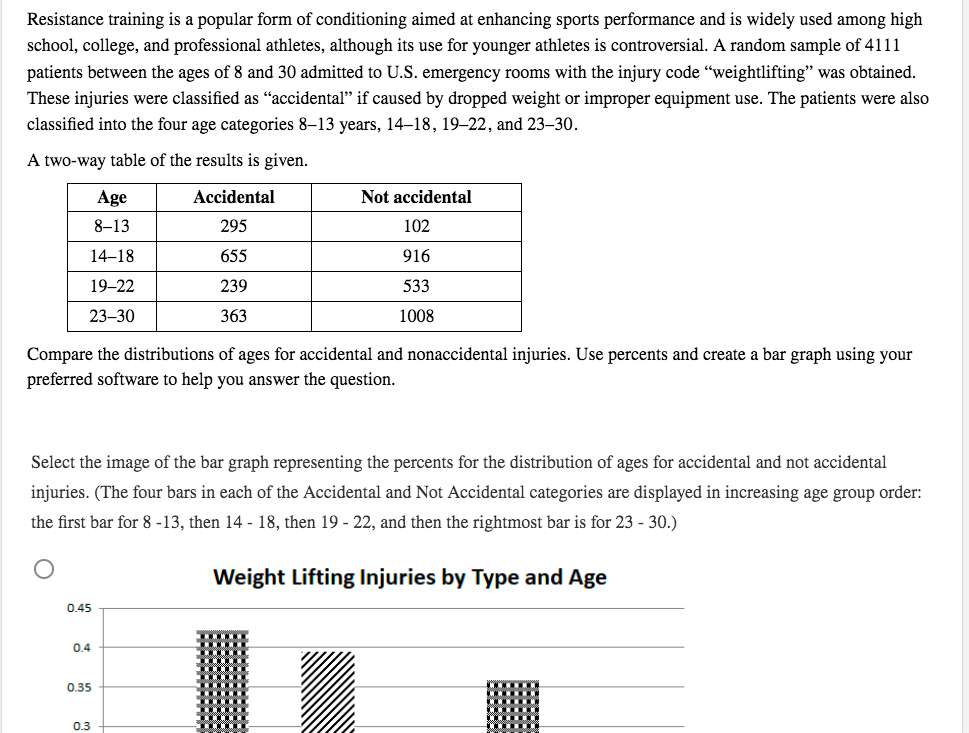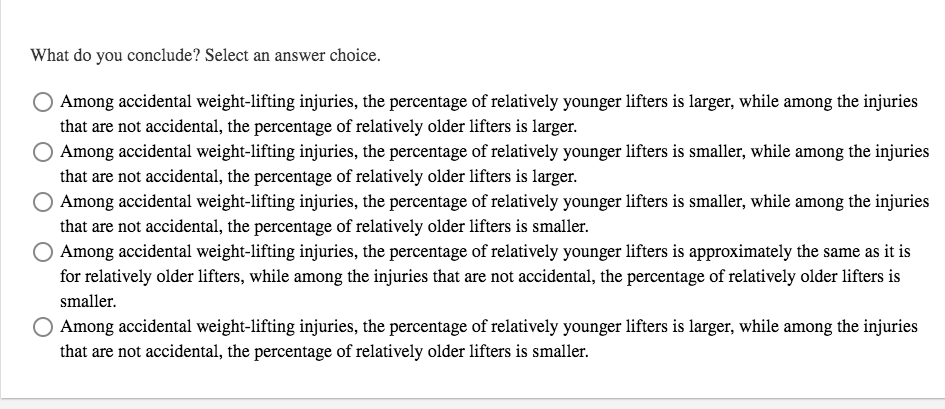What do you conclude? Select an answer choice. O Among accidental weight-lifting injuries, the percentage of relatively younger lifters is larger, while among the injuries that are not accidental, the percentage of relatively older lifters is larger. Among accidental weight-lifting injuries, the percentage of relatively younger lifters is smaller, while among the injuries that are not accidental, the percentage of relatively older lifters is larger. Among accidental weight-lifting injuries, the percentage of relatively younger lifters is smaller, while among the injuries that are not accidental, the percentage of relatively older lifters is smaller. O Among accidental weight-lifting injuries, the percentage of relatively younger lifters is approximately the same as it is for relatively older lifters, while among the injuries that are not accidental, the percentage of relatively older lifters is smaller. O Among accidental weight-lifting injuries, the percentage of relatively younger lifters is larger, while among the injuries that are not accidental, the percentage of relatively older lifters is smaller.
What do you conclude? Select an answer choice. O Among accidental weight-lifting injuries, the percentage of relatively younger lifters is larger, while among the injuries that are not accidental, the percentage of relatively older lifters is larger. Among accidental weight-lifting injuries, the percentage of relatively younger lifters is smaller, while among the injuries that are not accidental, the percentage of relatively older lifters is larger. Among accidental weight-lifting injuries, the percentage of relatively younger lifters is smaller, while among the injuries that are not accidental, the percentage of relatively older lifters is smaller. O Among accidental weight-lifting injuries, the percentage of relatively younger lifters is approximately the same as it is for relatively older lifters, while among the injuries that are not accidental, the percentage of relatively older lifters is smaller. O Among accidental weight-lifting injuries, the percentage of relatively younger lifters is larger, while among the injuries that are not accidental, the percentage of relatively older lifters is smaller.
Holt Mcdougal Larson Pre-algebra: Student Edition 2012
1st Edition
ISBN:9780547587776
Author:HOLT MCDOUGAL
Publisher:HOLT MCDOUGAL
Chapter11: Data Analysis And Probability
Section: Chapter Questions
Problem 8CR
Related questions
Question

Transcribed Image Text:Resistance training is a popular form of conditioning aimed at enhancing sports performance and is widely used among high
school, college, and professional athletes, although its use for younger athletes is controversial. A random sample of 4111
patients between the ages of 8 and 30 admitted to U.S. emergency rooms with the injury code "weightlifting" was obtained.
These injuries were classified as "accidental" if caused by dropped weight or improper equipment use. The patients were also
classified into the four age categories 8–13 years, 14–18, 19–22, and 23–30.
A two-way table of the results is given.
Age
Accidental
Not accidental
8-13
295
102
14–18
655
916
19–22
239
533
23-30
363
1008
Compare the distributions of ages for accidental and nonaccidental injuries. Use percents and create a bar graph using your
preferred software to help you answer the question.
Select the image of the bar graph representing the percents for the distribution of ages for accidental and not accidental
injuries. (The four bars in each of the Accidental and Not Accidental categories are displayed in increasing age group order:
the first bar for 8 -13, then 14 - 18, then 19 - 22, and then the rightmost bar is for 23 - 30.)
Weight Lifting Injuries by Type and Age
0.45
0.4
0.35
0.3

Transcribed Image Text:What do you conclude? Select an answer choice.
OAmong accidental weight-lifting injuries, the percentage of relatively younger lifters is larger, while among the injuries
that are not accidental, the percentage of relatively older lifters is larger.
Among accidental weight-lifting injuries, the percentage of relatively younger lifters is smaller, while among the injuries
that are not accidental, the percentage of relatively older lifters is larger.
Among accidental weight-lifting injuries, the percentage of relatively younger lifters is smaller, while among the injuries
that are not accidental, the percentage of relatively older lifters is smaller.
Among accidental weight-lifting injuries, the percentage of relatively younger lifters is approximately the same as it is
for relatively older lifters, while among the injuries that are not accidental, the percentage of relatively older lifters is
smaller.
Among accidental weight-lifting injuries, the percentage of relatively younger lifters is larger, while among the injuries
that are not accidental, the percentage of relatively older lifters is smaller.
Expert Solution
This question has been solved!
Explore an expertly crafted, step-by-step solution for a thorough understanding of key concepts.
This is a popular solution!
Trending now
This is a popular solution!
Step by step
Solved in 2 steps with 2 images

Knowledge Booster
Learn more about
Need a deep-dive on the concept behind this application? Look no further. Learn more about this topic, statistics and related others by exploring similar questions and additional content below.Recommended textbooks for you

Holt Mcdougal Larson Pre-algebra: Student Edition…
Algebra
ISBN:
9780547587776
Author:
HOLT MCDOUGAL
Publisher:
HOLT MCDOUGAL

College Algebra (MindTap Course List)
Algebra
ISBN:
9781305652231
Author:
R. David Gustafson, Jeff Hughes
Publisher:
Cengage Learning


Holt Mcdougal Larson Pre-algebra: Student Edition…
Algebra
ISBN:
9780547587776
Author:
HOLT MCDOUGAL
Publisher:
HOLT MCDOUGAL

College Algebra (MindTap Course List)
Algebra
ISBN:
9781305652231
Author:
R. David Gustafson, Jeff Hughes
Publisher:
Cengage Learning
